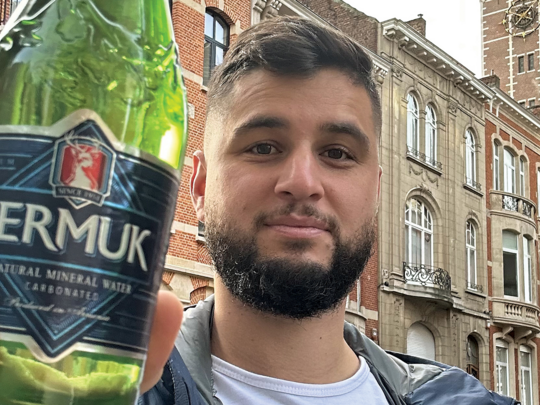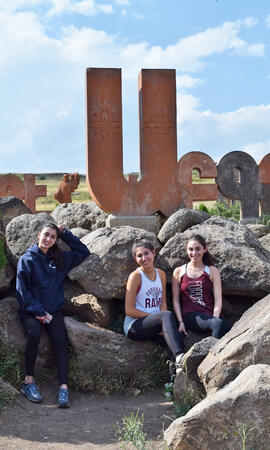The strong affinity between Armenia and Ethiopia dates back to as early as the 4th century AD, for the most part, due to the shared Christian faith and communion between Ethiopian Orthodox and Armenian Apostolic Churches. In fact, as early as the 7th century, Armenians had organized themselves into an established community reaching, at its apex, approximately 1,200 people in the wake of the 1915 Armenian Genocide.
As the population grew, so did the reputation, status, and privileges conferred upon the Armenians by the Ethiopian state, particularly during the reign of Emperor Menelik II (1889 to 1913). This formed the basis of a historical narrative that sets apart the Ethio-Armenian experience from other Armenians of the Diaspora, who were never quite equal to the majority population, let alone considered special and protected.
Unfortunately, this relatively small but powerful community went through a number of hardships—from the Italian occupation of Ethiopia, where most Armenians were persecuted as whites against whites due to their loyalty to the Emperor, to the 1974 Derg Revolution, when the socialists took over, confiscating their property and causing families to scatter across 27 countries of the world.
No matter how small, this community will never extinguish. If you enter the Armenian Church in Ethiopia now, it’s new as it has never been before, people ardently take care of it.
Today, only below 80 Ethio-Armenians remain in Ethiopia, along with remnants of their once glorious past.
Yet, the tragic and traumatic ending to the Armenians’ glory years appears to have been eclipsed by the collective longing of many Ethio-Armenians for a bygone era, when their identity was rooted in pride, accomplishment, values, and virtues.
Stories of Glory
In his interview to Richard Pankhurst in the summer of 1979, Avedis Terzian, the son of a prominent Ethio-Armenian trader and innovator Sarkis Terzian, recollects several stories highlighting the glory of Ethio-Armenians back in the imperial times.
Perhaps the most widely known story pertains to the Royal Band of 40 Armenian orphans and their conductor Kevork Nalbandian, whom Crown Prince Haile Selassie favored and brought to Ethiopia after the young musicians met the Ethiopian delegation in Jerusalem. Later, Nalbandian, an honored and talented musician and the author of Ethiopian anthem, with his nephew Nerses Nalbandian originated the foundation of Ethiopian music.

More importantly, during the reign of Emperor Menelik II, Armenians were entitled to property, which distinguished them from other minorities and allowed them to head up the rental activities in the Empire. The historical forty houses built into an Armenian District (Armen Sefer) in the center of the capital Addis Ababa are the standing proof of it.
Terzian recollects how the Armenians were able to trade their goods for arms with the West, making Ethiopia the only African state to possess arms against colonial powers. Armenians were also credited for their masterful construction and industrial development. The first road in Ethiopia was partially built thanks to a steam-powered rock-crushing machine privately imported from Austria by Sarkis Terzian. Although it broke down halfway three years later, it had a massive role in taking the country’s infrastructure to a new level. To this day, the area where the machine broke down is called Sebara Babur, which means “the broken steam.” Later, a number of streets were engineered by the Emperor’s Chief Civil Engineer, Minas Gherbekian.
Royal Filwaha, the bath of hot springs, is another signature Armenian architectural masterpiece. Commissioned by the Emperor to honor his consort, the bath housed three sections and soon became the Empress’ favorite place.
Then came the first hotel of Addis Ababa designed and constructed by Architect Krikor Hovian. Hotel Taitu is still a historical treasure in Addis Ababa. “The hotel withstood two major colonial wars, socialist revolts, and most recently, it survived the fire in 2015,” mentions Aramazt Kalayjian in his “Tezeta” documentary. It even housed Jazzamba—the most prestigious jazz club of the capital city.
Virtue is its Own Reward
“Ethiopian-Armenians were the trusted confidants of the Emperor,” cited every Ethio-Armenian who responded to our anonymous survey, upon the first mention of the community’s history. Jewelers, traders, royal translators and photographers, innovators, and even ambassadors and delegation heads—Armenians were shining in every corner of the Empire.

While famous stories of glory account for the most part of the Ethio-Armenian collective memory, most have their own family stories as a source of pride. “My father, Bedros Aslanian, founded and established (with partners) Ethiopia’s first paper-converting and packaging press, while my maternal grandfather, George Djerrahian, established Ethiopia’s first private printing press with his brother Elias in 1931,” shared one respondent.
Historically, Armenians of Ethiopia had no political affiliation—neither within the country nor among themselves—which allowed Emperor Menelik II to deepen his trust in Armenians. On the flip side, sharing equal rights as citizens with Ethiopians had its disadvantages, such as during the throes of the Derg revolution. In this instance, other minorities managed to avoid socialist prosecutions and were able to shield themselves in their respective foreign embassies as foreigners, whereas Ethiopians and Armenians, as lawful and equal citizens of the country, suffered handing over their property and valuable possessions to the state. In that sense, Ethio-Armenians lost a homeland rather than a host country.
To this end, one respondent, Garbis Korajian, who declined to remain anonymous, proudly shared his family story, centered around his grandfather, who served as a palace treasurer for 40 years. “During the Italian occupation, my grandfather was arrested and sent to Italy with his wife and six children as a prisoner of war. The highest loyalty demonstrated by my family—not having betrayed their adopted country but instead serving seven years of prison term—has always made me proud.”
A Nostalgia-Driven Identity
While stories of imperial times make Ethio-Armenians proud, it’s their fond memories of their close-knit Armenian community that triggers nostalgic sentiments. “We had one school, one church, and one club, which were the heart and soul of the Armenian community life,” is how Korajian described it. “Extended families built their homes on shared land to maintain close ties between relatives. We went everywhere together, played together, then went to church on Sundays. Everyone knew everyone, which kept us strong, happy, and united.”

As the core of the Ethiopian-Armenian friendship, the Armenian Church was a sacred place to visit even for the Emperor. Another Ethio-Armenian recalled seeing Haile Selassie’s Rolls Royce stop in front of the Armenian church. “He went inside our church to pray. My family said it was common for him to do so.”
There is also nostalgia for vacations with family and friends at Lake Langano or Mojo Adama. “A dozen Armenian families got together and planned a camping trip to Lake Langano, some 210 kilometers south of Addis Ababa,” wrote another respondent. “We were a large group of families enjoying an entire camping experience for a few days—a very memorable and impressive experience for us, the kids.”

In fact, Korajian, who is writing a book about Ethiopian-Armenian history, notes that Armenian people of different classes in Ethiopia had their special place at the lakes for family retreats. The wealthy retreated to their summer mansions, while the middle class stayed to the hotels that catered only to Armenians on weekends. In the evenings, special festivities were organized with Armenian food, stories, songs, and music. “Armenians of Ethiopia lived their best lives there, and Ethiopia became a home for us,” he concludes.
The Last 80?
Against all odds, the Ethiopian-Armen-ians remain strong, bonded, and well-informed about one another, longing for two homelands—Armenia and Ethiopia. Though they do engage with the Armenian communities of their new host countries, when it comes to reunions, they prefer to confine it to their own Ethio-Armenian circle and preferably meet
in an Ethiopian restaurant to catch up and indulge in their special brand of nostalgia.
You can take Armenians out of Ethiopia, but you will never take Ethiopia out of Ethio-Armenians.
Hampartsum and Marie Ghazarossian have had an instrumental role in keeping those ties strong and gathering the old community together. For the last reunion, there were attendees from 13 different U.S. states and ten countries—around 300 people in all.
Still, establishing and maintaining new close ties in the Diaspora seems challenging for them, leaving them with a feeling as if something is missing—the good old days.
In the meantime, in Ethiopia, the royal narratives that bonded Armenians and Ethiopians are fading away among the new generation of Ethiopians. However, the remaining small community is determined to inform every coming generation of Ethiopians about the Armenian contributions to the Ethiopian land and deepen already existing favorable ties. “No matter how small, this community will never extinguish. If you enter the Armenian Church in Ethiopia now, it’s new as it has never been before, people ardently take care of it.”

Ethiopia. Photo Credit: Ariadne Van Zandbergen/Alamy
One thing is crystal clear—despite their diminished presence on the Ethiopian land, Ethiopian-Armenians are committed to their community worldwide, tied to a proud identity embedded in their psyches—a presence of things past to be shared among themselves, fellow Armenians, and generations to come. Best stated by one of the community members living abroad, “You can take Armenians out of Ethiopia, but you will never take Ethiopia out of Ethio-Armenians.”





















